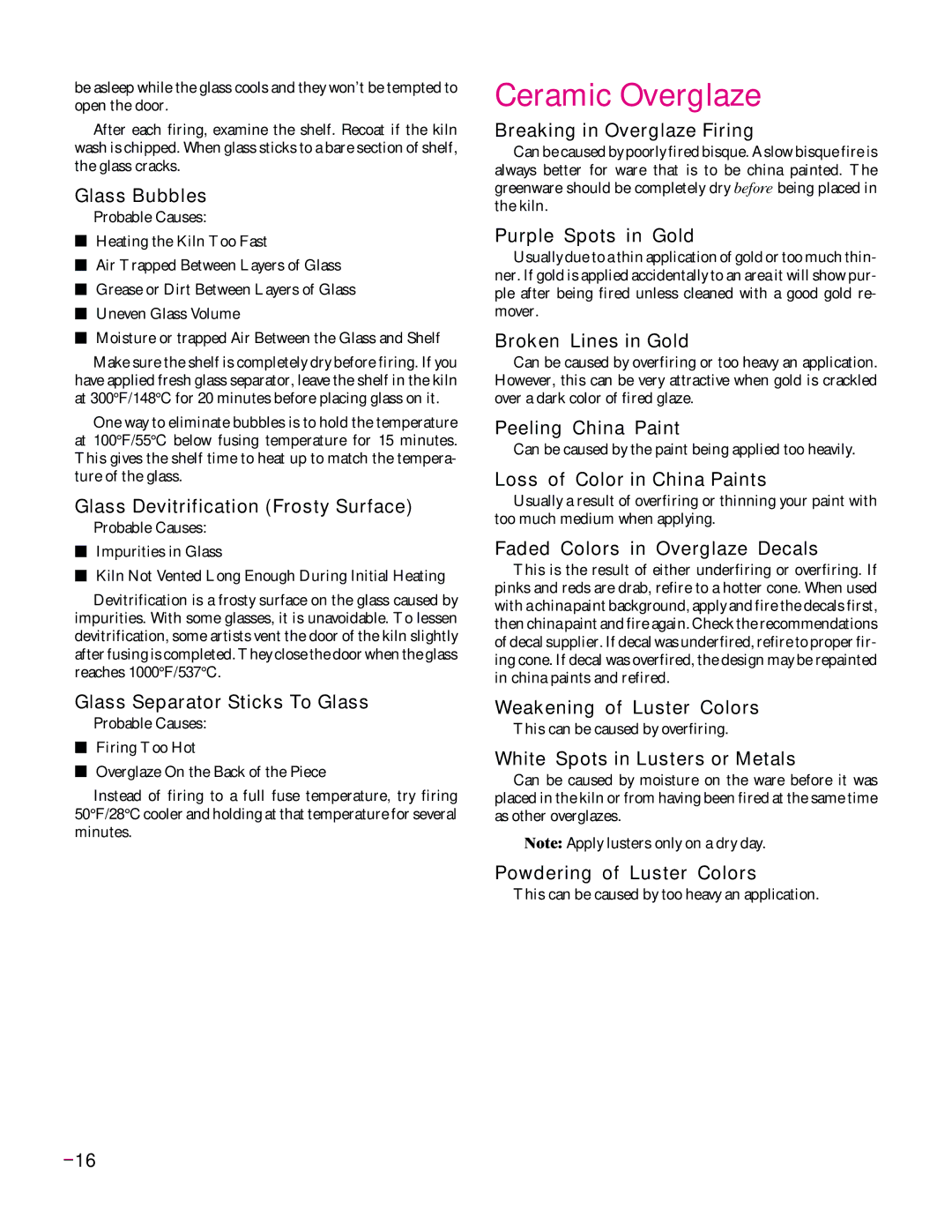be asleep while the glass cools and they won’t be tempted to open the door.
After each firing, examine the shelf. Recoat if the kiln wash is chipped. When glass sticks to a bare section of shelf, the glass cracks.
Glass Bubbles
Probable Causes:
■Heating the Kiln Too Fast
■Air Trapped Between Layers of Glass
■Grease or Dirt Between Layers of Glass
■Uneven Glass Volume
■Moisture or trapped Air Between the Glass and Shelf
Make sure the shelf is completely dry before firing. If you have applied fresh glass separator, leave the shelf in the kiln at 300°F/148°C for 20 minutes before placing glass on it.
One way to eliminate bubbles is to hold the temperature at 100°F/55°C below fusing temperature for 15 minutes. This gives the shelf time to heat up to match the tempera- ture of the glass.
Glass Devitrification (Frosty Surface)
Probable Causes:
■Impurities in Glass
■Kiln Not Vented Long Enough During Initial Heating
Devitrification is a frosty surface on the glass caused by impurities. With some glasses, it is unavoidable. To lessen devitrification, some artists vent the door of the kiln slightly after fusing is completed. They close the door when the glass reaches 1000°F/537°C.
Glass Separator Sticks To Glass
Probable Causes:
■Firing Too Hot
■Overglaze On the Back of the Piece
Instead of firing to a full fuse temperature, try firing 50°F/28°C cooler and holding at that temperature for several minutes.
Ceramic Overglaze
Breaking in Overglaze Firing
Can be caused by poorly fired bisque. A slow bisque fire is always better for ware that is to be china painted. The greenware should be completely dry before being placed in the kiln.
Purple Spots in Gold
Usually due to a thin application of gold or too much thin- ner. If gold is applied accidentally to an area it will show pur- ple after being fired unless cleaned with a good gold re- mover.
Broken Lines in Gold
Can be caused by overfiring or too heavy an application. However, this can be very attractive when gold is crackled over a dark color of fired glaze.
Peeling China Paint
Can be caused by the paint being applied too heavily.
Loss of Color in China Paints
Usually a result of overfiring or thinning your paint with too much medium when applying.
Faded Colors in Overglaze Decals
This is the result of either underfiring or overfiring. If pinks and reds are drab, refire to a hotter cone. When used with a china paint background, apply and fire the decals first, then china paint and fire again. Check the recommendations of decal supplier. If decal was underfired, refire to proper fir- ing cone. If decal was overfired, the design may be repainted in china paints and refired.
Weakening of Luster Colors
This can be caused by overfiring.
White Spots in Lusters or Metals
Can be caused by moisture on the ware before it was placed in the kiln or from having been fired at the same time as other overglazes.
Note: Apply lusters only on a dry day.
Powdering of Luster Colors
This can be caused by too heavy an application.
16
